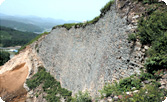World Heritage
Tentative List
- Kangjingun Kiln Sites (1994)
- Mt.Soraksan Nature Reserve (1994)
- Sites of fossilized dinosaurs throughout the Southern seacoast (2002)
- Salterns (2010)
- Southwestern Coast Tidal Flats (2010)
- Daegokcheon Stream Petroglyphs (2010)
- Ancient Mountain Fortresses in Central Korea (2010)
- Oeam Village (2011)
- Naganeupseong, Town Fortress and Village (2011)
- Upo Wetland (2011)
- Seoul City Wall (2012)
- Stone Buddhas and Pagodas at Hwasun Unjusa Temple(2017)
- Gaya Tumuli (2019)
 The property refers to the sites of national defenses located in Chungcheongbuk-do,
the central region of Korea, which display major characteristics of sanseong or mountain fortresses from ancient times, through the middle ages, to modern times.
The property refers to the sites of national defenses located in Chungcheongbuk-do,
the central region of Korea, which display major characteristics of sanseong or mountain fortresses from ancient times, through the middle ages, to modern times.
Korea is called "a country of sanseong (mountain fortress)." The ancestors of present-day Korean people developed unique defense facilities by using the natural environment of the Korean peninsula where mountains and hills are abundant. To date, almost 2,400 mountain fortress sites large and small have been found in Korea. There are 212 mountain fortress sites in Chungcheongbuk-do, the central region of Korea.
The mountain fortresses of Korea have been consistently evolved in design and construction. Not only were the early types of mountain fortresses developed toward perfection by virtue of historical experience, but they were also developed to enhance defensive abilities in the process of repelling foreign invaders. In this respect, the mountain fortress in Korea can be identified as historical monuments achieved by the outstanding cultural ability of the Korean people.
With its long history, the whole country is dotted with mountain fortresses. However, the most representative and unique ones are concentrated in the central part of the nation.
The characteristics and features of mountain fortresses in central Korea are summarized as follows: First, it contains prominent evidence that vividly demonstrates the culture of the past. In particular, it allows us to investigate the interaction between the culture that prospered in central Korea and neighboring cultures such as the southernmost site of the Goguryeo Kingdom, whose heritage was already inscribed on the World Heritage List, and the Tang Dynasty of China. It also permits us to conduct comparative research on the military facilities of such cultures.
Second, it shows a unique form. The mountain fortresses in central Korea have unique defensive system, in diverse forms, which make the best use of their topography and demonstrate distinctive technique in construction throughout the ages. They provide representative evidence for the research of both defense and offense military strategies since ancient times. With regard to the construction technology, they are comparable to fortresses of neighboring countries. There are seven representative mountain fortresses in the central region of Korea. They include Samnyeonsanseong Fortress in Boeun, Sangdangsanseong Fortress in Cheongju, Chungjusanseong Fortress in Chungju, Jangmisanseong Fortress in Chungju, Deokjusanseong Fortress in Jecheon, Ondalsanseong Fortress in Danyang, and Mireuksanseong Fortress in Goesan.
Samnyeonsanseong at Boeun, a stone-built fortress, can be considered as a representative mountain fortress of ancient Korea since its date of construction is firmly recorded. Sangdangsanseong in Cheongju was a fortress located at the center of traffic and defense of Korea's central region from the middle ages to modern times. As a cluster of historic sites, Deokjusanseong in Jecheon, Chungjusanseong, Jangmisanseong of Chungju, and the Gate of Joryeong Path in Mungyeong are all defensive facilities for military purposes located in a single scenic area. These sites are linked by a traffic route between the Han River and the Nakdonggang River, which has been used since the ancient times onward. In addition, it is rich with a historical, intangible cultural heritage ranging from legends, religious and cultic remains.
Ondalsanseong in Danyang is a representative site bearing the marks of the southward advance of the Goguryeo Kingdom and the northward expansion of the Silla Kingdom respectively. Its fortress wall attests to the respective methods of construction peculiar to the Goguryeo and Silla kingdoms. Mireuksanseong at Goesan, constructed in the middle period of the Goryeo Dynasty, demonstrates characteristics of mountain fortresses built in the medieval period.
Each of these seven mountain fortresses constructs a unique defensive system which makes the best use of traffic routes, linking adjacent mountains and watercourses. All of the seven mountain fortresses, with their intact states, demonstrate the military, architectural, and construction technology of the time. Furthermore, they have reliable records. Thanks to academic research and preservation efforts, ample materials concerning these mountain fortresses have been handed down to us. In the vicinity of these mountain fortresses, there are ancient tomb mounds and diverse cultural sites of traditional cults, religions, and popular folk religions. In sum, these mountain fortresses are historical sites of outstanding value.



 >
>